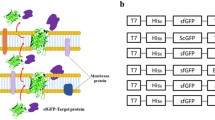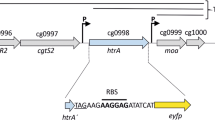Abstract
The advantages of using traceable fluorescent protein (enhanced green fluorescent protein; EGFP) and a secretory alkaline phosphatase (SEAP) have been used to generate a reporter gene: the secretory fluorescent protein (SEFP). Sf21 cells, infected with the recombinant baculovirus containing the SEFP gene, revealed both traceable fluorescence and easily detectable alkaline phosphatase activity in the culture medium. The distribution of SEFP within the cells revealed that it was excluded from the nucleus, implying that the accumulation of SEFP in a secretory pathway, similar to that of the secretion signal-tagged FPs. Furthermore, the time- and dose-dependent release from the blockage of brefeldin A (BFA) confirmed that the secretion of SEFP was mediated by the secretion pathway and excluded leakage from viral infection. This SEFP reporter gene with traceable fluorescence and alkaline phosphatase activity may become a useful tool for studies on secretory protein production.



Similar content being viewed by others
References
Abbate J, Lacayo JC, Prichard M, Pari G, McVoy MA (2001) Bifunctional protein conferring enhanced green fluorescence and puromycin resistance. BioTechniques 31:336–340
Ailor E, Betenbaugh MJ (1999) Modifying secretion and post-translational processing in insect cells. Curr Opin Biotechnol 10:42–145
Bennett RP, Cox CA, Hoeffler JP (1998) Fusion of green fluorescent protein with the Zeocin-resistance marker allows visual screening and drug selection of transfected eukaryotic cells. BioTechniques 24:478–482
Chen YJ, Chen WS, Wu TY (2005) Development of a bi-cistronic baculovirus expression vector by the Rhopalosiphum padi virus 5′ internal ribosome entry site. Biochem Biophys Res Commun 335:616–623
Giepmans BN, Adams SR, Ellisman MH, Tsien RY (2006) The fluorescent toolbox for assessing protein location and function. Science 312:217–224
Klausner RD, Donaldson JG, Lippincott-Schwartz J (1992) Brefeldin A: insights into the control of membrane traffic and organelle structure. J Cell Biol 116:1071–1080
Kost TA, Condreay JP, Jarvis D (2005) Baculovirus as versatile vectors for protein expression in insect and mammalian cells. Nat Biotechnol 23:567–575
Laukkanen ML, Oker-Blom C, Keinanen K (1996) Secretion of green fluorescent protein from recombinant baculovirus-infected insect cells. Biochem Biophys Res Commun 226:755–761
Lee JC, Wu TY, Huang CF, Yang FM, Shih SR, Hsu JT (2005) High-efficiency protein expression mediated by enterovirus 71 internal ribosome entry site. Biotechnology and bioengineering 90:656–662
Liu J, Szalay WY, Escher A (2000) Visualizing and quantifying protein secretion using a Renilla luciferase-GFP fusion protein. Luminescence 15:45–49
Misumi Y, Misumi Y, Miki K, Takatsuki A, Tamura G, Ikehara Y (1986) Novel blockade by brefeldin A of intracellular transport of secretory proteins in cultured rat hepatocytes. J Biol Chem 261:11398–11403
Naylor LH (1999) Reporter gene technology: the future looks bright. Biochemical pharmacology 58:749–757
Sambrook J, Fritsch EF, Maniatis T (2001) Molecular cloning: a laboratory manual, 3nd ed. Cold Spring Harbor Laboratory Press, Cold Spring Harbor
Tsien RY (1998) The green fluorescent protein. Annu Rev Biochem 67:509–544
Yun EY, Goo TW, Kim SW, Choi KH, Hwang JS, Kang SW, Kwon OY (2005) Changes in cellular secretory processing during baculovirus infection. Biotechnol Lett 27:1041–1045
Acknowledgements
This work was supported by a grant NSC-94-2317-B-033-001 from the National Science Council of Taiwan. And support from The Center-of-Excellence Program on Membrane Technology, the Ministry of Education of Taiwan.
Author information
Authors and Affiliations
Corresponding author
Rights and permissions
About this article
Cite this article
Teng, CY., Wu, TY. Secretory fluorescent protein, a secretion green fluorescent fusion protein with alkaline phosphatase activity as a sensitive and traceable reporter in baculovirus expression system. Biotechnol Lett 29, 1019–1024 (2007). https://doi.org/10.1007/s10529-007-9349-y
Received:
Revised:
Accepted:
Published:
Issue Date:
DOI: https://doi.org/10.1007/s10529-007-9349-y




